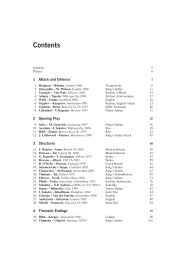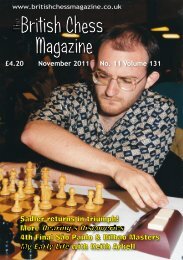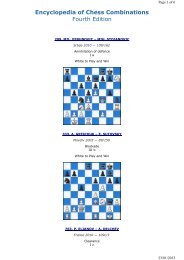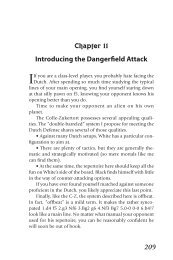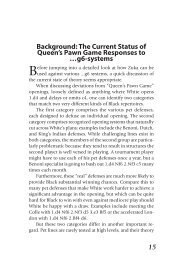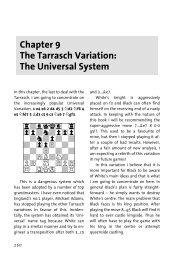The Sicilian Defence Lubomir Ftacnik - Chess Direct Ltd
The Sicilian Defence Lubomir Ftacnik - Chess Direct Ltd
The Sicilian Defence Lubomir Ftacnik - Chess Direct Ltd
You also want an ePaper? Increase the reach of your titles
YUMPU automatically turns print PDFs into web optimized ePapers that Google loves.
<strong>The</strong> <strong>Sicilian</strong> <strong>Defence</strong><br />
By<br />
<strong>Lubomir</strong> <strong>Ftacnik</strong><br />
Quality <strong>Chess</strong><br />
www.qualitychess.co.uk
First edition 2010 by Quality <strong>Chess</strong> UK <strong>Ltd</strong><br />
Copyright © 2010 <strong>Lubomir</strong> <strong>Ftacnik</strong><br />
Grandmaster Repertoire 6 - <strong>The</strong> <strong>Sicilian</strong> <strong>Defence</strong><br />
All rights reserved. No part of this publication may be reproduced, stored<br />
in a retrieval system or transmitted in any form or by any means, electronic,<br />
electrostatic, magnetic tape, photocopying, recording or otherwise, without prior<br />
permission of the publisher.<br />
Paperback ISBN 978-1-906552-08-4<br />
Hardcover ISBN 978-1-906552-07-7<br />
All sales or enquiries should be directed to Quality <strong>Chess</strong> UK <strong>Ltd</strong>,<br />
20 Balvie Road, Milngavie, Glasgow G62 7TA, United Kingdom<br />
Phone +44 141 227 6771<br />
e-mail: info@qualitychess.co.uk<br />
website: www.qualitychess.co.uk<br />
Distributed in US and Canada by SCB Distributors, Gardena, California, US<br />
www.scbdistributors.com<br />
Distributed in Rest of the World by Quality <strong>Chess</strong> UK <strong>Ltd</strong> through<br />
Sunrise Handicrafts, Smyczkowa 4/98, 20-844 Lublin, Poland<br />
Typeset by Jacob Aagaard<br />
Proofreading and computer checking by Colin McNab<br />
Additional analysis by Jacob Aagaard and Christoph Tiemann<br />
Edited by Andrew Greet<br />
Cover design by Adamson Design<br />
Printed in Estonia by Tallinna Raamatutrükikoja LLC
Creating the Grandmaster Repertoire series seemed a natural idea. <strong>The</strong>re is a glut of opening<br />
books at the Starting Out level. <strong>The</strong>se books have certainly been refreshing, but they have<br />
almost completely replaced high-level opening books.<br />
As chess fans, we felt we were missing out, and because we can, we decided to do<br />
something about it.<br />
<strong>The</strong> books in the Grandmaster Repertoire series are written by grandmasters, edited by<br />
grandmasters, and will certainly be read by grandmasters. This does not mean that players<br />
who are not grandmasters cannot read them. We have worked hard to make our books<br />
clear in their presentation and to make it possible for the readers to decide the depth to<br />
which they want to study them.<br />
When we were young and trying to be up-and-coming, we understood that you do not<br />
have to remember everything in an opening book in order to use it. It is our hope that those<br />
readers who find this repertoire too extensive and detailed, will ignore many of the details.<br />
Even now that we are grandmasters, we see the bolded moves as what we want to memorize,<br />
and the notes as explanations and illustrations.<br />
It is our conviction that you will eventually be more successful by playing the main lines,<br />
simply because they are based on better moves. Instinctively most players know this, but<br />
they fear losing to a prepared line and thus turn to unambitious systems, or unhealthy<br />
surprises. <strong>The</strong> opponent will not be able to use his preparation but, sadly, will not need it.<br />
<strong>The</strong>se sidelines generally end in uninspiring positions almost automatically.<br />
Possibly the main reason why high-level opening books have disappeared is the rise of<br />
databases. It has been assumed that there is no point in having traditional opening books<br />
anymore, as you can look it all up in the database. Some rather lazy authors have a system:<br />
collect a few hundred games from the database, give Fritz a few moments, then hit Print.<br />
Such books add nothing to chess literature. We have seen enough of them and have never<br />
wanted to add to that pile.<br />
In these days of multi-million game databases, we all have access to information, what<br />
is lacking is understanding. In the Grandmaster Repertoire series, very strong players will<br />
share their understanding and suggest strong new moves that are in no one else’s database.<br />
We are excited about this series and hope that the reader will share some of that<br />
excitement.<br />
John Shaw & Jacob Aagaard<br />
Quality <strong>Chess</strong>
Contents<br />
Key to symbols used & Bibliography 6<br />
From Russia Sicily with Love - Introduction 7<br />
Minor Systems<br />
1 Pandora’s (<strong>Chess</strong>) Box - Miscellaneous 2nd moves 9<br />
2 Some Like It Hot - <strong>The</strong> Morra Gambit 29<br />
3 Forrest Gump - <strong>The</strong> c3-Variation 37<br />
Closed Systems<br />
4 Up Close(d) and Personal - Without g3 67<br />
5 A Bridge Too Far - 3.g3 85<br />
Anti-Open Systems<br />
6 Fight Club - Various 101<br />
7 Blade Runner - 3.¥b5† 119<br />
8 <strong>The</strong> Last Samurai - 4.£xd4 133<br />
Minor Open Lines<br />
9 <strong>The</strong> Misfits - 6th Move Sidelines 149<br />
10 Sideways - 6.g3 161<br />
11 <strong>The</strong> Karate Kid - 6.h3 175<br />
12 Pulp Fiction - 6.f4 183<br />
13 <strong>The</strong> Rock - 6.¥e2 207<br />
14 Midnight Express - 6.¥c4 251
English Attack<br />
15 <strong>The</strong> English Patient - 6.¥e3 e5 285<br />
16 Predator - Perenyi Attack: 6.¥e3 e6 7.g4 323<br />
17 Four Weddings and a Funeral - 6.¥e3 e6 7.f3 333<br />
Classic Main Line<br />
21 License to Kill - 6.¥g5 e6 379<br />
22 Blood Diamond - 6.¥g5 ¤bd7 405<br />
Variation index 420
Introduction<br />
From Russia Sicily with Love<br />
First I would like to express my gratitude to the reader for opening this book on the <strong>Sicilian</strong><br />
<strong>Defence</strong>. Credit must go to the Quality <strong>Chess</strong> team and their excellent authors whose efforts<br />
resulted in the creation of a real buzz about the Grandmaster Repertoire series. To follow in the<br />
footsteps of the previous titles made for a daunting challenge and I hope that the present book,<br />
the sixth volume in the series, will live up to the readers’ high expectations.<br />
<strong>The</strong> unparalleled popularity of the <strong>Sicilian</strong> has led to the creation of an entire chess galaxy that is<br />
too vast for even the best and brightest minds to comprehend fully. Each player chooses his Kan,<br />
Sveshnikov, Dragon or other pet variation, around which he creates his own <strong>Sicilian</strong> world. My<br />
own modest expertise lies in the domains of the Najdorf and Scheveningen systems, which I have<br />
been playing and studying over the past two decades. <strong>The</strong> Scheveningen system represents a kind<br />
of foundational core, from which virtually all knowledge about thematic <strong>Sicilian</strong> structures and<br />
plans can be traced. Although the official subject of this book is the Najdorf variation, the two<br />
systems share many common themes and can often transpose to one another. In certain places,<br />
such as Chapters 12 and 13 (which deal with the variations 6.f4 and 6.¥e2 respectively), the<br />
decision to recommend the response 6...e6, instead of equally valid alternatives such as 6...e5,<br />
was influenced by my fondness for the Scheveningen set-up. I make no apologies for this, as I<br />
believe that an author can make the most useful contribution when writing about his own areas<br />
of expertise.<br />
At the end of the day this repertoire book is about cherry-picking the best and brightest ideas<br />
from the enormous jungle of variations available. In some sense the repertoire is notable not only<br />
for the recommendations that were included, but also for the attractive ones that (sometimes after<br />
agonizing deliberations) did not make the final cut. <strong>The</strong> whole <strong>Sicilian</strong> <strong>Defence</strong> creates something<br />
of a ‘win-win’ situation, in the sense that the unbalanced positions often result in bloodshed for<br />
one side or the other. In some variations Black may have to defend for a while, but it rarely kills<br />
his chances for a subsequent counterattack and ultimate success.<br />
I have tried to address all the most important ideas in every chapter, but practice will inevitably<br />
bring some new challenges, so please be prepared for some surprises. Nobody can foresee the<br />
future – it is often difficult enough to ‘predict’ the past (just ask any decent historian).<br />
I have often hankered for a bit of colour in our seemingly dry, black and white world of technical<br />
annotations, symbols and diagrams. As a young man I came across a game that is played in social<br />
situations, involving association with the names of films. Movies can often be symbolic, full of<br />
cultural references and associative bridges – evoking colours and emotions unlike any other form
8 Introduction<br />
of media. I hope for some readers the chapter titles will evoke some positive feelings and help to<br />
place the struggle to master chess into a broader perspective.<br />
This entire project has at times threatened to pull me down and drag me under the deep waters<br />
of endless lines and multiplying ideas. I am greatly indebted for the help and encouragement of<br />
John Shaw, Jacob Aagaard and Andrew Greet of Quality <strong>Chess</strong>. <strong>The</strong> love, care and understanding<br />
of my wife Katarina went so far that she is happy to be woven between the lines.<br />
I appreciate the attention of any reader who glances beyond this preface. <strong>The</strong> main rule of the<br />
survival guide in Black’s <strong>Sicilian</strong> galaxy is to Die Another Day – be prepared to go under at any<br />
moment, but try to resist and strike back. <strong>The</strong> final (or should that be Fatal) attraction of the<br />
<strong>Sicilian</strong> is the fact that it is truly dangerous – for both sides!<br />
<strong>Lubomir</strong> <strong>Ftacnik</strong><br />
Bratislava, June 2010
4<br />
Chapter<br />
Closed Systems<br />
Up Close(d) and Personal - Without g3<br />
Variation Index<br />
1.e4 c5 2.¤c3<br />
1222222223<br />
tMvWlVmT5<br />
Oo+oOoOo5<br />
+ + + +5<br />
+ O + + 5<br />
+ +p+ +5<br />
+ N + + 5<br />
pPpP PpP5<br />
R BqKbNr5<br />
79<br />
2...d6<br />
A) 3.¤ge2 68<br />
B) 3.d4 70<br />
C) 3.f4 g6 4.¤f3 ¥g7 71<br />
C1) 5.d4 cxd4 6.¤xd4 ¤c6 7.¥e3 ¤f6 8.¥e2 0–0 72<br />
C11) 9.0–0! 72<br />
C12) 9.¤b3 74<br />
C2) 5.¥b5† ¥d7 6.¥xd7† £xd7 7.0–0 ¤c6 8.d3 ¤f6 75<br />
C21) 9.h3 75<br />
C22) 9.¥d2 77<br />
C3) 5.¥c4 ¤c6 6.0–0 ¤f6 77<br />
C31) 7.£e1 78<br />
C32) 7.d3 0–0 8.£e1 ¤d4 79<br />
C321) 9.f5! 79<br />
C322) 9.¤xd4 81<br />
C323) 9.¥b3 82<br />
C21) after 17.¤d5<br />
1222222223<br />
+ T Tl+5<br />
O + OoVo5<br />
Om+ +o+5<br />
+ OnPw+m5<br />
+ + P Q5<br />
+ + +n+p5<br />
pPp+ Bp+5<br />
+ +r+rK 5<br />
79<br />
17...¦xd5!<br />
C31) after 14.£xf1<br />
1222222223<br />
t+vW +l+5<br />
Oo+ + Vo5<br />
+ +o+o+5<br />
+ OmO + 5<br />
+ N + +5<br />
+bNp+ + 5<br />
pPp+ +pP5<br />
R B +qK 5<br />
79<br />
14...cxd4!N<br />
C323) 17.¥xe7<br />
1222222223<br />
t+ + Tl+5<br />
+o+mBoVo5<br />
W + +o+5<br />
+ + +p+ 5<br />
o+ Oo+ +5<br />
+ +p+ + 5<br />
pPp+nQpP5<br />
R + +rK 5<br />
79<br />
17...¦fe8N
Chapter 4 - Without g3<br />
79<br />
Black has an extra pawn and healthy central<br />
control. True, the extra e-pawn may not<br />
be hurting White directly, but it certainly<br />
improves Black’s control over the important<br />
central squares.<br />
C32) 7.d3<br />
1222222223<br />
t+vWl+ T5<br />
Oo+ OoVo5<br />
+mO Mo+5<br />
+ O + + 5<br />
+b+pP +5<br />
+ Np+n+ 5<br />
pPp+ +pP5<br />
R Bq+rK 5<br />
79<br />
This is the standard developing move.<br />
7...0–0 8.£e1<br />
White’s entire system is geared towards<br />
a kingside attack, and this move plays a key<br />
role. White’s typical plan involves some<br />
combination of f5, £h4, ¥h6, ¤g5 followed<br />
by mate on h7. It is all rather crude, but can<br />
certainly be dangerous if Black does not know<br />
how to respond.<br />
Sometimes White switches things around with<br />
the immediate:<br />
8.f5 e6<br />
As mentioned previously, it would be risky<br />
to accept the pawn, although it may be<br />
theoretically okay.<br />
9.fxg6<br />
9.£e1 is well met by 9...d5!, which gives Black<br />
good chances to fight for the advantage, for<br />
instance: 10.¥b3 c4! 11.dxc4 dxe4 12.¤xe4<br />
¤xe4 13.£xe4 exf5, Vo Hong Phuong – Xu<br />
Yuhua, Istanbul (ol) 2000.<br />
9...fxg6 10.¥g5 h6 11.¥h4<br />
It is a similar story after 11.¥d2 d5 12.exd5<br />
exd5 13.¥b3 ¢h7 14.£e1 ¥g4³. Black has<br />
all his pieces in play and the b3-bishop has<br />
trouble finding a useful role.<br />
11...g5 12.¥e1 d5 13.¥b3 ¤a5³<br />
White’s position was already becoming<br />
uncomfortable, Meulner – Ploetz, Wildflecken<br />
1988.<br />
8...¤d4<br />
1222222223<br />
t+vW Tl+5<br />
Oo+ OoVo5<br />
+ O Mo+5<br />
+ O + + 5<br />
+bMpP +5<br />
+ Np+n+ 5<br />
pPp+ +pP5<br />
R B QrK 5<br />
79<br />
Here we will consider the ultra-aggressive<br />
but not quite sound C321) 9.f5!, followed by<br />
the calmer alternatives of C322) 9.¤xd4 and<br />
C323) 9.¥b3.<br />
C321) 9.f5!<br />
This was tried in Gofshtein – Pigusov, Bourbon<br />
Lancy 1997, and does not appear to have been<br />
repeated since.<br />
9...¤xc2!N<br />
Black must not be intimidated. He should<br />
be able to survive the attack and win with his<br />
extra material, although strong nerves may be<br />
required at certain key moments.<br />
10.£h4 ¤xa1<br />
From this point on, the key to Black’s<br />
defence will be to neutralize the c4-bishop.
80 Closed Systems<br />
<strong>The</strong> goal might be achieved by capturing the<br />
bishop outright, diverting it away from the<br />
a2-g8 diagonal, or blocking the said diagonal.<br />
Once this had been achieved, the remaining<br />
defensive moves should not be too difficult<br />
to find, as you can see in the following<br />
variations.<br />
1222222223<br />
t+vW Tl+5<br />
Oo+ OoVo5<br />
+ O Mo+5<br />
+ O +p+ 5<br />
+b+p+ Q5<br />
+ Np+n+ 5<br />
pP + +pP5<br />
M B +rK 5<br />
79<br />
11.¥h6<br />
11.fxg6 should be met by 11...¥e6!,<br />
immediate going after the bishop. 12.gxh7†<br />
(After 12.gxf7† ¥xf7 Black should defend<br />
without much difficulty, for instance: 13.¥xf7†<br />
¦xf7 14.¤g5 ¤c2 15.¤d5 [15.¤xf7 ¢xf7<br />
16.£xh7 ¤d4–+] 15...£f8–+) 12...¢h8<br />
13.¥xe6 fxe6 14.¤g5<br />
1222222223<br />
t+ W T L5<br />
Oo+ O Vp5<br />
+ OoM +5<br />
+ O + N 5<br />
+ +p+ Q5<br />
+ Np+ + 5<br />
pP + +pP5<br />
M B +rK 5<br />
79<br />
14...¤g4! 15.¤xe6 ¥d4† 16.¤xd4 cxd4<br />
17.¦xf8† £xf8 18.£xg4 dxc3 19.bxc3 £f7<br />
and Black should win.<br />
11...b5!<br />
Once again, the c4-bishop is the target.<br />
11...e6! seems to be playable, but the text<br />
move is so obviously strong that there is no<br />
point in analysing anything else in detail.<br />
It should briefly be noted that 11...d5 is much<br />
worse, for instance: 12.¤xd5 ¤xd5 13.¤g5!<br />
¤f6 14.fxg6 hxg6 15.¥xg7 ¢xg7 16.¦xf6+–<br />
12.¥xb5<br />
12.fxg6 bxc4 gives White nothing;<br />
alternatively after 12.¥d5 ¤xd5 13.¤xd5<br />
Black kills the attack with 13...f6!–+.<br />
<strong>The</strong> following line is more interesting: 12.¤xb5<br />
d5! Having drawn the knight away from the<br />
centre, this becomes an excellent move. Once<br />
again we are targeting the bishop. 13.¥xd5<br />
¤xd5 14.¤g5! <strong>The</strong> best try. 14...¤f6 15.fxg6<br />
fxg6 16.¥xg7 ¢xg7 17.¦xf6 ¢xf6! 18.e5†<br />
¢xe5<br />
1222222223<br />
t+vW T +5<br />
O + O +o5<br />
+ + +o+5<br />
+nO L N 5<br />
+ + + Q5<br />
+ +p+ + 5<br />
pP + +pP5<br />
M + + K 5<br />
79<br />
<strong>The</strong> king is surprisingly safe, for instance:<br />
19.£e4† ¢f6 20.¤xh7† ¢g7 21.¤xf8 ¥f5<br />
and Black wins.<br />
12...¤c2!<br />
<strong>The</strong> knight is not only safeguarding itself<br />
from a potential capture, but also playing an<br />
active role in the defence.<br />
13.¥c4
Other moves are no better, for instance:<br />
13.¤g5 ¤e3! Not only attacking the rook,<br />
but also threatening ...¥xh6 followed by<br />
...¤eg4.<br />
13...¤d4 14.¤g5 e6!<br />
Thanks to the lost tempo involved in White’s<br />
¥xb5-c4 manoeuvre, Black had enough<br />
time to recentralize his knight, supporting<br />
the pawn on e6 and thereby preventing the<br />
bishop on c4 from playing an active role in the<br />
attack.<br />
1222222223<br />
t+vW Tl+5<br />
O + +oVo5<br />
+ OoMoB5<br />
+ O +pN 5<br />
+bMp+ Q5<br />
+ Np+ + 5<br />
pP + +pP5<br />
+ + +rK 5<br />
79<br />
15.fxg6<br />
<strong>The</strong>re is not much else that White can do.<br />
15...fxg6 16.¥xg7 ¢xg7 17.¦xf6 h6!–+<br />
<strong>The</strong> attack runs out of steam. As you can see,<br />
a certain amount of precision was required in<br />
order to defend correctly. At the same time, the<br />
ideas were quite easy to understand and follow:<br />
just take away the influence of the bishop on<br />
c4, and everything else more or less falls into<br />
place.<br />
C322) 9.¤xd4 cxd4<br />
<strong>The</strong> direct exchange in the centre may be<br />
White’s best option, although it is not much of<br />
a try for an advantage.<br />
Chapter 4 - Without g3<br />
81<br />
1222222223<br />
t+vW Tl+5<br />
Oo+ OoVo5<br />
+ O Mo+5<br />
+ + + + 5<br />
+bOpP +5<br />
+ Np+ + 5<br />
pPp+ +pP5<br />
R B QrK 5<br />
79<br />
10.¤d5<br />
White should avoid 10.¤e2! d5! 11.exd5<br />
¤xd5 when the resulting pawn structure<br />
favours Black. Here is one example: 12.£f2<br />
¤e3 (Also interesting is 12...b5!N 13.¥xb5<br />
£b6 with promising compensation.) 13.¥xe3<br />
dxe3 14.£xe3 ¥xb2 15.¦ab1 ¥g7 16.£f3 ¦b8<br />
17.¤g3 e6 18.¢h1 b6 With the bishop pair and<br />
a sounder structure, Black was in full control in<br />
Kolosowski – Nedilko, Warsaw 2006.<br />
10.¤d1 is not so bad, although Black should<br />
be able to obtain a comfortable game after<br />
10...d5 11.¥b3 dxe4 12.dxe4, Armbrust –<br />
Fruebing, Willingen 2006. In this position it<br />
looks promising to pre-empt the possible e5-<br />
push with 12...¤d7!N 13.¤f2 £c7 14.¤d3<br />
a5! 15.a4 ¤c5 16.¤xc5 £xc5 when Black has<br />
good chances on the queenside.<br />
10...¤xd5 11.¥xd5<br />
White can also consider 11.exd5, J. Peters<br />
– D. Lee, Los Angeles 1999. White wants to<br />
attack along the e-file, but the downside is that<br />
his bishop has a restricted view of the board.<br />
Black should develop calmly with 11...¥d7N<br />
with the possible continuation 12.a4 a5<br />
13.¥d2 ¦e8, with roughly even chances.<br />
11...e6 12.¥b3 a5 13.a4 ¢h8!<br />
This is a sensible precaution.



